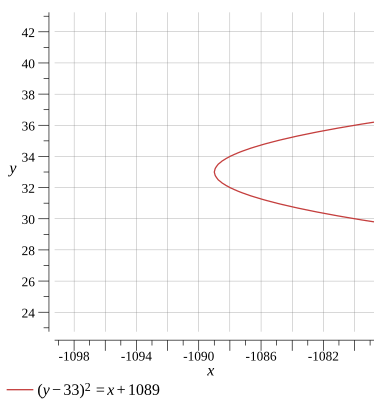Question
Identify the conic
Find the standard equation of the parabola
Find the vertex of the parabola
Find the focus of the parabola
Load more

(y−33)2=x+1089
Evaluate
x=y2−6y×11
Multiply the terms
x=y2−66y
Swap the sides of the equation
y2−66y=x
To complete the square, the same value needs to be added to both sides
y2−66y+1089=x+1089
Solution
(y−33)2=x+1089
Show Solution

Solve the equation
Solve for x
Solve for y
x=y2−66y
Evaluate
x=y2−6y×11
Solution
x=y2−66y
Show Solution

Testing for symmetry
Testing for symmetry about the origin
Testing for symmetry about the x-axis
Testing for symmetry about the y-axis
Not symmetry with respect to the origin
Evaluate
x=y2−6y11
Simplify the expression
x=y2−66y
To test if the graph of x=y2−6y11 is symmetry with respect to the origin,substitute -x for x and -y for y
−x=(−y)2−66(−y)
Evaluate
More Steps


Evaluate
(−y)2−66(−y)
Multiply the numbers
(−y)2−(−66y)
Rewrite the expression
(−y)2+66y
Rewrite the expression
y2+66y
−x=y2+66y
Solution
Not symmetry with respect to the origin
Show Solution

Find the first derivative
Find the derivative with respect to x
Find the derivative with respect to y
dxdy=2y−661
Calculate
x=y2−6y11
Simplify the expression
x=y2−66y
Take the derivative of both sides
dxd(x)=dxd(y2−66y)
Use dxdxn=nxn−1 to find derivative
1=dxd(y2−66y)
Calculate the derivative
More Steps


Evaluate
dxd(y2−66y)
Use differentiation rules
dxd(y2)+dxd(−66y)
Evaluate the derivative
More Steps


Evaluate
dxd(y2)
Use differentiation rules
dyd(y2)×dxdy
Use dxdxn=nxn−1 to find derivative
2ydxdy
2ydxdy+dxd(−66y)
Evaluate the derivative
More Steps


Evaluate
dxd(−66y)
Use differentiation rules
dyd(−66y)×dxdy
Evaluate the derivative
−66dxdy
2ydxdy−66dxdy
1=2ydxdy−66dxdy
Swap the sides of the equation
2ydxdy−66dxdy=1
Collect like terms by calculating the sum or difference of their coefficients
(2y−66)dxdy=1
Divide both sides
2y−66(2y−66)dxdy=2y−661
Solution
dxdy=2y−661
Show Solution

Find the second derivative
Find the second derivative with respect to x
Find the second derivative with respect to y
dx2d2y=−4y3−396y2+13068y−1437481
Calculate
x=y2−6y11
Simplify the expression
x=y2−66y
Take the derivative of both sides
dxd(x)=dxd(y2−66y)
Use dxdxn=nxn−1 to find derivative
1=dxd(y2−66y)
Calculate the derivative
More Steps


Evaluate
dxd(y2−66y)
Use differentiation rules
dxd(y2)+dxd(−66y)
Evaluate the derivative
More Steps


Evaluate
dxd(y2)
Use differentiation rules
dyd(y2)×dxdy
Use dxdxn=nxn−1 to find derivative
2ydxdy
2ydxdy+dxd(−66y)
Evaluate the derivative
More Steps


Evaluate
dxd(−66y)
Use differentiation rules
dyd(−66y)×dxdy
Evaluate the derivative
−66dxdy
2ydxdy−66dxdy
1=2ydxdy−66dxdy
Swap the sides of the equation
2ydxdy−66dxdy=1
Collect like terms by calculating the sum or difference of their coefficients
(2y−66)dxdy=1
Divide both sides
2y−66(2y−66)dxdy=2y−661
Divide the numbers
dxdy=2y−661
Take the derivative of both sides
dxd(dxdy)=dxd(2y−661)
Calculate the derivative
dx2d2y=dxd(2y−661)
Rewrite the expression in exponential form
dx2d2y=dxd((2y−66)−1)
Calculate the derivative
More Steps


Evaluate
dxd((2y−66)−1)
Evaluate the derivative
−(2y−66)−2×dxd(2y−66)
Evaluate the derivative
−(2y−66)−2×2dxdy
Calculate
−2dxdy×(2y−66)−2
dx2d2y=−2dxdy×(2y−66)−2
Rewrite the expression
dx2d2y=−(2y−66)22dxdy
Calculate
dx2d2y=−2(y−33)2dxdy
Use equation dxdy=2y−661 to substitute
dx2d2y=−2(y−33)22y−661
Solution
More Steps


Calculate
−2(y−33)22y−661
Divide the terms
More Steps


Evaluate
2(y−33)22y−661
Multiply by the reciprocal
2y−661×2(y−33)21
Multiply the terms
(2y−66)×2(y−33)21
Use the commutative property to reorder the terms
2(2y−66)(y−33)21
−2(2y−66)(y−33)21
Expand the expression
More Steps


Evaluate
2(2y−66)(y−33)2
Expand the expression
2(2y−66)(y2−66y+1089)
Multiply the terms
(4y−132)(y2−66y+1089)
Apply the distributive property
4y×y2−4y×66y+4y×1089−132y2−(−132×66y)−132×1089
Multiply the terms
4y3−4y×66y+4y×1089−132y2−(−132×66y)−132×1089
Multiply the terms
4y3−264y2+4y×1089−132y2−(−132×66y)−132×1089
Multiply the numbers
4y3−264y2+4356y−132y2−(−132×66y)−132×1089
Multiply the numbers
4y3−264y2+4356y−132y2−(−8712y)−132×1089
Multiply the numbers
4y3−264y2+4356y−132y2−(−8712y)−143748
If a negative sign or a subtraction symbol appears outside parentheses, remove the parentheses and change the sign of every term within the parentheses
4y3−264y2+4356y−132y2+8712y−143748
Subtract the terms
4y3−396y2+4356y+8712y−143748
Add the terms
4y3−396y2+13068y−143748
−4y3−396y2+13068y−1437481
dx2d2y=−4y3−396y2+13068y−1437481
Show Solution

Rewrite the equation
r=0r=sin2(θ)cos(θ)+66sin(θ)
Evaluate
x=y2−6y×11
Evaluate
x=y2−66y
Move the expression to the left side
x−y2+66y=0
To convert the equation to polar coordinates,substitute x for rcos(θ) and y for rsin(θ)
cos(θ)×r−(sin(θ)×r)2+66sin(θ)×r=0
Factor the expression
−sin2(θ)×r2+(cos(θ)+66sin(θ))r=0
Factor the expression
r(−sin2(θ)×r+cos(θ)+66sin(θ))=0
When the product of factors equals 0,at least one factor is 0
r=0−sin2(θ)×r+cos(θ)+66sin(θ)=0
Solution
More Steps


Factor the expression
−sin2(θ)×r+cos(θ)+66sin(θ)=0
Subtract the terms
−sin2(θ)×r+cos(θ)+66sin(θ)−(cos(θ)+66sin(θ))=0−(cos(θ)+66sin(θ))
Evaluate
−sin2(θ)×r=−cos(θ)−66sin(θ)
Divide the terms
r=sin2(θ)cos(θ)+66sin(θ)
r=0r=sin2(θ)cos(θ)+66sin(θ)
Show Solution

Graph
